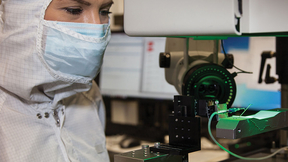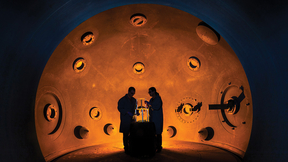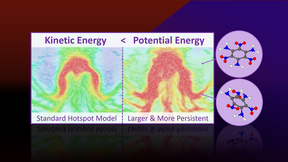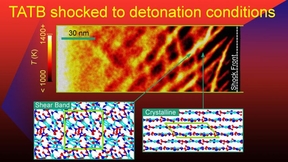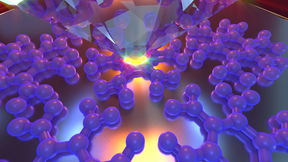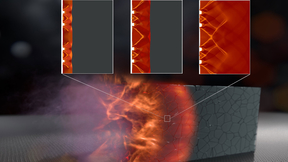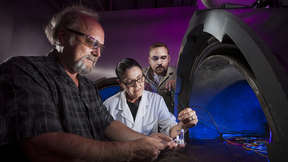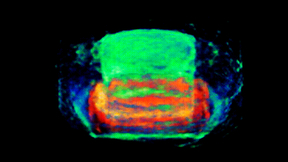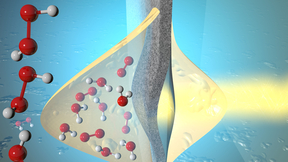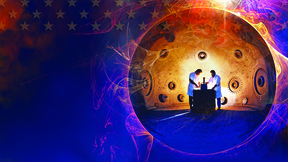Back
Second Lt. Hannah Fletcher, a 2021 Lawrence Livermore National Laboratory (LLNL) Reserve Officer Training Corps (ROTC) summer intern, has been named the 2022 United States Air Force (USAF) Cadet of the Year. This award recognizes the best cadet in an Air Force commissioning program based on military performance, academics and physical fitness. LLNL’s ROTC internship…
Scientists at the Lawrence Livermore National Laboratory (LLNL) Energetic Materials Center and Purdue University Materials Engineering Department used simulations performed on the LLNL supercomputer Quartz to uncover a general mechanism that accelerates chemistry in detonating explosives critical to managing the nation’s nuclear stockpile. Their research is featured in the…
Lawrence Livermore National Laboratory researchers aligned energetic materials knowledge and high-energy-density science expertise with experimental capabilities at the world’s most energetic laser, the National Ignition Facility.
Ana Racoveanu is able to do something most others throughout the nuclear security enterprise cannot do — something challenging and extremely valuable throughout the complex. Racoveanu, a staff scientist in Lawrence Livermore National Laboratory’s Materials Science Division, is able to synthesize energetic compounds with isotopic labels. The primary goal of this work is to…
High explosive (HE) research, development, test and evaluation work at Lawrence Livermore National Laboratory (LLNL) continues to meet the needs of the nation on behalf of the National Nuclear Security Administration (NNSA). One specific effort is the HE pressing capability, which is a critical component of the LLNL’s national security mission. The scope of the Lab’s HE…
Since Lawrence Livermore’s inception in 1952, Laboratory researchers have been among the nation’s leaders in understanding, synthesizing, formulating, testing, assessing, and modeling the initiation systems and energetic materials (EM) that play an integral role in the U.S. nuclear deterrent, conventional munitions, and homeland security. The Laboratory’s Energetic…
Research conducted on Lawrence Livermore National Laboratory’s (LLNL) supercomputer Quartz highlights findings made by scientists that reveal a missing aspect of the physics of hotspots in TATB (1,3,5-trimamino-2,4,6-trinitrobenzene) and other explosives. Hotspots are localized regions of elevated temperature that form from shock-induced collapse of microstructural…
The first-ever shot to study a high explosive sample was recently conducted at the National Ignition Facility (NIF), the world’s most energetic laser. The results from the shot included novel data that will help researchers unlock the mysteries of high-explosive (HE) chemistry and position Lawrence Livermore National Laboratory (LLNL) to continue its legacy as a leader in…
Two Lawrence Livermore National Laboratory (LLNL) scientists have discovered a new mechanism for ignition of high explosives that explains the unusual detonation properties of 1,3,5-triamino-2,4,6-trinitrobenzene (TATB). The research will allow for systematic improvements to continuum mechanics models used to assess the performance and safety of the material accurately and…
Lawrence Livermore National Laboratory (LLNL) scientists in collaboration with University of Nevada Las Vegas (UNLV) have discovered a previously unknown pressure induced phase transition for TATB that can help predict detonation performance and safety of the explosive. The research appears in the May 13 online edition of the Applied Physics Letters and it is highlighted…
A team of scientists at Lawrence Livermore National Laboratory (LLNL) has shown that the structure of microscopic pores in high explosive materials can significantly impact performance and safety. These findings -- published recently as the cover article in the journal Propellants, Explosives, Pyrotechnics -- open the door to the possibility of tuning high explosives by…
At Lawrence Livermore, a key aspect of stockpile stewardship includes fine-tuning and experimentally observing HE detonation processes and developing computer models to predict the behavior of different HEs. Over the last several decades, HE detonation science has progressed toward higher resolution experimental and modeling capabilities that explore initiation processes,…
Lawrence Livermore National Laboratory (LLNL) scientists and collaborators at Los Alamos National Laboratory (LANL) for the first time have taken 3D snapshots of operating high explosive detonators. Scientists from LLNL, Los Alamos and National Security Technologies, LLC (NSTech) combined state-of-the-art imaging capabilities with computed tomographic reconstruction (X-ray…
Energetic materials—explosives, propellants, and pyrotechnics—are substances that store and release large amounts of chemical energy. They are made by either physically mixing solid oxidizers and fuels to produce a composite energetic material, such as gunpowder, or by creating a molecule that contains both oxidizing and fuel components, such as TNT.
Lara Leininger has been selected to lead Lawrence Livermore National Laboratory’s (LLNL) Energetic Materials Center (EMC).Created 25 years ago, the EMC’s mission is to integrate state-of-the-art capabilities in high explosives, propellants, thermites and pyrotechnics for the benefit of the Stockpile Stewardship Program and other National Nuclear Security Administration…
Lawrence Livermore National Laboratory researchers have combined ultrafast time-resolved experimental measurements with theory to reveal how an explosive responds to a high-impact shock.The work involved advances in both ultrafast experimental shock wave methods and molecular dynamics (MD) simulation techniques, and the combination of experiment and simulation is a…
Since its founding in 1991, Livermore’s Energetic Materials Center (EMC) has been the focal point for research and development of explosives, propellants, and pyrotechnics at the Laboratory. EMC provides oversight and direction for high explosives efforts at Livermore, ensuring full advantage is taken of Laboratory-wide capabilities.



